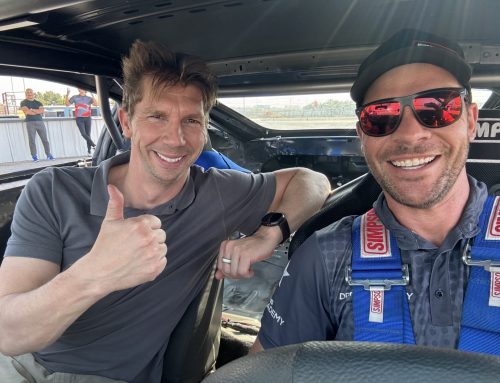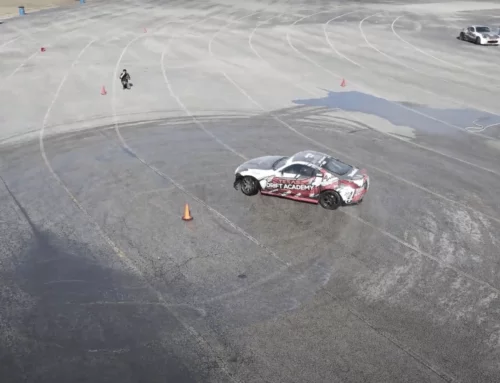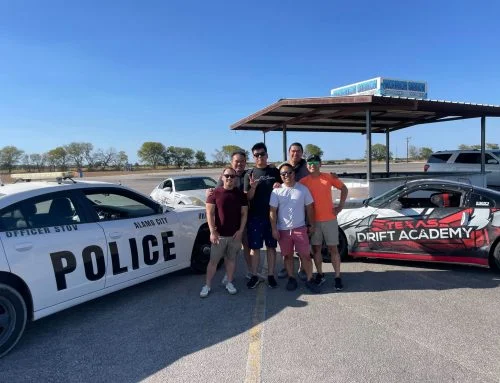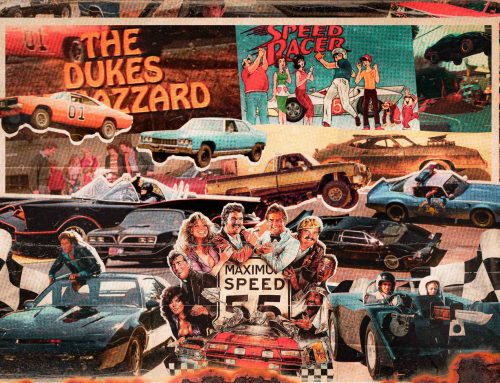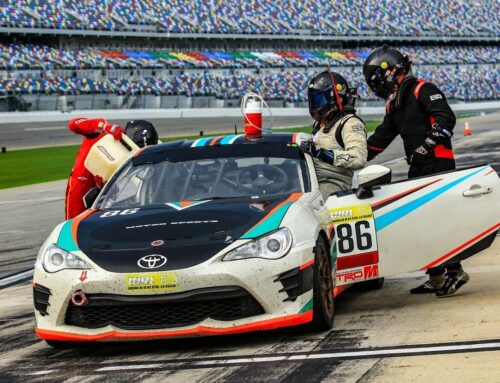We had the privilege of interviewing Samuel Hubinette (@samuel_hubinette). This interview is unique from hundreds he’s done before. This is the first to dive into his tips and techniques for drifting, stunt driving, car set up and more.
Still, we should give an introduction to the first FD drift champion and stunt driving legend who got his start with Fast and Furious Tokyo Drift. Who is Samuel Hubinette? The highlights:
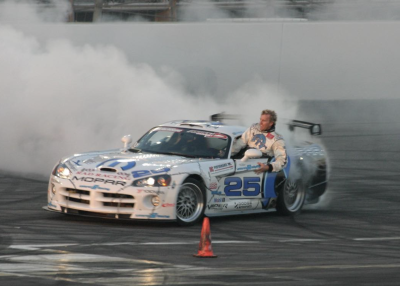 Most people call him Sam. Friends and family call him Samuel. Nicknamed “The Crazy Swede” early in his career. He learned to drive at 8 years old on frozen lakes in Sweden in a diesel Mercedes. His first car was an Opel Manta GTE (4 cylinder RWD, like a Nissan 240). Sam spent 9 years testing Volvos. Touring car racing. Road Racing in Saab. Ice drifting Volvos. He eventually entered and became champion of the first Formula Drift competition in 2004, and again in 2006. He won the D1 Grand Prix champion in Supra. Took X-Games podium in AWD Rally cars. His favorite? Traxxas off road truck racing. And he did the Baja 1000. He stunts in his own Lamborghini Huracan and BMW M3+M5. He’s one of the most prolific Stunt Driver sfor various movies (3 Fast & Furious movies, Ford vs. Ferrari, Need for Speed, and at least 10 others), plus many car commercials. He’s been a driving instructor for different schools. There’s a lot on him: 45,000 google search results on his name. Jim Liaw (Formula Drift founder) calls him the G.O.A.T.. In short, Sam is one of the most versatile and adaptable professional drivers of our day.
Most people call him Sam. Friends and family call him Samuel. Nicknamed “The Crazy Swede” early in his career. He learned to drive at 8 years old on frozen lakes in Sweden in a diesel Mercedes. His first car was an Opel Manta GTE (4 cylinder RWD, like a Nissan 240). Sam spent 9 years testing Volvos. Touring car racing. Road Racing in Saab. Ice drifting Volvos. He eventually entered and became champion of the first Formula Drift competition in 2004, and again in 2006. He won the D1 Grand Prix champion in Supra. Took X-Games podium in AWD Rally cars. His favorite? Traxxas off road truck racing. And he did the Baja 1000. He stunts in his own Lamborghini Huracan and BMW M3+M5. He’s one of the most prolific Stunt Driver sfor various movies (3 Fast & Furious movies, Ford vs. Ferrari, Need for Speed, and at least 10 others), plus many car commercials. He’s been a driving instructor for different schools. There’s a lot on him: 45,000 google search results on his name. Jim Liaw (Formula Drift founder) calls him the G.O.A.T.. In short, Sam is one of the most versatile and adaptable professional drivers of our day.
You drove a Viper, Charger, and Challenger for competition and drive a Lamborghini for stunts. How do you approach drifting & stunt driving differently between larger cars vs. smaller cars?
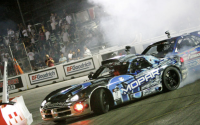
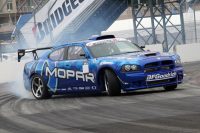
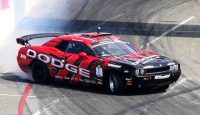
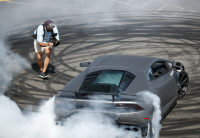
Regarding how you drive a larger car to a smaller car is a great question. It all comes down to, first of all, what are we trying to achieve? Are we doing a competition, trying to do tandem drifting, or are we going on a job and doing a car commercial downtown LA and asked to slide a Dodge Charger from curb to curb between other cars?
First of all, yes, I did compete in a lot of the bigger platform vehicles. And it was actually not by choice. I was sponsored by Dodge when we got into drifting when Formula Drift was founded in 2004. Mopar wanted to be part of it. The only car at the time they had that was going to be competitive – I mean somewhat competitive – was a Viper. It was not a car they preferred to use because it was so expensive.
And it was not an easy car to drift. It had very little steering angle. At the first event in Atlanta 2004 I didn’t even have a handbrake, so I had to flick it. Basically I just drifted from a flick to the side.
I was just looking back at this. It looked terrible. But it’s what we had. And with massive power and traction I got a gap with the competitors back then, and there were no rules. So my advantage was like, I’m just going to try to get a gap and because I was out to win, I had to use my advantage. And yes, we did win the championship that first year. It was a very important win for me, way more than I could imagine at that time. Drifting was not that big and it was a dream come true to win the first one. It was the biggest moment of my professional career. I dreamt my whole life to be paid to compete.
So anyway, that’s how it started and why we ended up in the Viper. And then we built another one the year after which was more purpose built, a Viper from a regular SRT
Can you walk through how you execute the Hubinette 360?
It’s not easy if you lack space. It comes down to a lot of calculation to not end up in the wrong place, especially with camera cars around you. Generally nowadays you don’t have a handbrake. So you need to have enough power so you can actually drift into basically keep the wheel spins and make a flick to get the rotation and momentum to make a car start rotating.
So I tend to do it counterclockwise most of the time. It just seems to be my favorite. I can do both ways, but I definitely realize I like to do it counterclockwise.
So what happens is I first judge the space and the speed. You like to do it around 60 miles per hour preferably because then you come out of it with some speed so it looks better. Otherwise, it’s basically stalled and looks kind of lame. But let’s say you get this space. Again, this is without handbrake and you have to have power so you can actually flick it with momentum to drift in it. You have to make a flick and then turn left hard and then power into that. So you make as much rotation as soon as the car starts coming to a forward 180. Put the clutch down if you have one. If not, it helps to get in neutral. Now you’re turning full right. Then the car will do a reverse 180. Then put it in drive again. Accelerate out so it looks pretty and straight as you come out of it. You want to make it look clean. It’s hard to explain because I don’t even think when I’m doing it. It’s all routine.
How does the 360 technique differ between different kinds of cars?
It all depends on the kind of equipment you have… how good the handbrake is, what kind of surface, and what traction you have. So, between a Viper and an M3, if you have similar handbrakes that are really locking up good and then it comes down to how much grip you have on tires.
There’s a lot of elements involved here because if you, let’s say you jump in a stock Viper, and you’re trying to do 360. It has massive tires, on the front too. The car comes around to a 180 basically, but after that it’s going to do a reverse 180 because a 360 combination is that forward 180 into a reverse 180. But it’s not going to want to do the reverse 180 because the front tires have so much traction, so they’re going to grip and it’s going to make the car possibly just turn around and actually move into a whole other lane and not even come around into a reverse 180.
So that will be something you have to consider if you’re doing it with a car with lots of front grip. The M3 doesn’t have as much front grip, so it will be easier to do it if you haven’t done modifications to it.
If we’re talking about 360s, there is a car that is very hard to do a 360. It’s a Hellcat red eye. They have the same size of tires in the front and the rear. They have 315s or whatever and they’re really really grippy. I have been asked to do 360s with those in downtown LA for commercials and I ran into some sketchy situations. I don’t have a handbrake, so basically I’m doing a power over. So I’m doing a sideways drift and then with momentum flicking it over. Then the problem is it doesn’t have enough momentum so then the front catches with all the massive grip you have and doesn’t want to just come around easily to that last part, which is the reverse 180. So you’re trying to make it rotate more with more power to make it flick over. But the problem is, as soon as you tap the throttle, it just rolls the tires and you don’t get the speed. It just spins the tires so much. So you have to basically just give half throttle. But with the supercharger it goes from too much wheel spin to not enough wheel spin very easy. If I had enough space I would do a third gear preferable. But it gets even trickier because you have to use the left foot brake to keep those tires spinning in third gear. If you get too much traction, it just kind of wants to go straight. Now you can’t even make it flick around your first 180. The key will be to raise that tire pressure as much as you can in front. You ideally want to put smaller tires on the whole car, especially the front.
And if you do have a handbrake?
Yeah, so you can do the same approach. Let’s say in our own personal M3 with a supercharger. You got power now, but you also have a handbrake and clutch. So you can just make it snappier and better.
You can power over to start the drift, but at the same time as you come around, clutch down as it rotates and pull the handbrake to make it slide around better. And as soon as you get into this reverse 180 situation, you release the clutch and accelerate out of it.
If it’s a front wheel drive car with a handbrake, it helps to do a flick. You can’t drift a flick, but it helps to do load transfer so you get the car to lose some traction to make it snap around better. And then you pull the handbrake at the same time and it will come around and it’s gonna be the same thing. Clutch down if you have one or neutral. You don’t wanna get a car to rotate backwards and destroy the engine.
If it doesn’t come around fully, then the cars start traveling in directions you don’t wanna go. It could be very dangerous and cause you to end up in some bad place.
As you think about stunts for commercials or movies, what are the most typical car modifications?
If we talk about when we do movies, there’s a lot of people involved and there’s unfortunately a tight budget all the time, even in a big picture movie. The financial situation can always be a struggle.
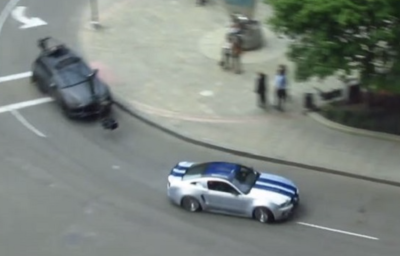 Let’s take the movie, Need for Speed. There was a Mustang for Aaron Paul. That car actually came out very good. We put smaller tires in the rear, so you have less traction. This allows us to take down the speed. And we added a little extra steering angle because there was a lot of drifting. I think we had a handbrake in it, which takes more budget. And, hopefully you get a couple of guys who can do it right so it actually works. Because many times it looks all good. Then I show up and try it and it doesn’t work. It was built wrong. You end up not using it. The guys couldn’t test it much because they’re doing it in some shop, who knows where, and they don’t have a place to test it out. And if you can put a little bigger engine just to have the power, and stick shift, that’s the dream scenario. But that doesn’t happen very often. And again, it didn’t happen there, but you just work with what you have.
Let’s take the movie, Need for Speed. There was a Mustang for Aaron Paul. That car actually came out very good. We put smaller tires in the rear, so you have less traction. This allows us to take down the speed. And we added a little extra steering angle because there was a lot of drifting. I think we had a handbrake in it, which takes more budget. And, hopefully you get a couple of guys who can do it right so it actually works. Because many times it looks all good. Then I show up and try it and it doesn’t work. It was built wrong. You end up not using it. The guys couldn’t test it much because they’re doing it in some shop, who knows where, and they don’t have a place to test it out. And if you can put a little bigger engine just to have the power, and stick shift, that’s the dream scenario. But that doesn’t happen very often. And again, it didn’t happen there, but you just work with what you have.
On top of that we had Ken Block, the GOAT himself, setting the level so high with his amazing cars. And so the director says, “we want you to do that with our car…”. Well he had a 1500 hp, AWD, monster car built for what he does. And I’m in a Kia here, and you want me to do the same thing. And they say, “Oh yeah, you should be fine. Sam, you can figure out. It’s gonna be great. You can do it.” But no, I can’t. Unfortunately, I can’t make that happen. And they don’t understand. It’s an interesting industry because some people don’t understand car dynamics.
There are these key moments that unlock driving skills and capabilities. Tell me about any moments in your career when you had an “unlocking moment” of a skill or your progression.
Months ago you and I touched on the right way to do a 90 parallel slide (“Hard Park” or slide in a box).
I did the Bobby Ore stunt school when I came here around 1998. I didn’t know anyone in the industry. So I was like, I’m just gonna have to start somewhere. Let’s go to a school and maybe someone else will be there. In this tiny little business word.
Before I did Bobby’s school, when I slid into a box, I tended to always do a little Scandinavian flick and get rotation. The problem is you’re adding more to something that should be as simple as possible to be consistent. So if I do a left-right, flick into a left-hand 90 it’s way harder to be consistent and put it in the same place every time. And that’s something I have to admit, I learned from Bobby Ore.
I came there young and very confident in my skills. And I was one of those students who had a hard time listening to him. But then I tried that and I was like wow! If you come straight, at the same speed, clutch down, pull the handbrake in the same place, let it slide for a little bit, just turn a little turn at the same angle, the car’s gonna end up pretty much at the same place every time. That is one of those things I took with me. And it was humbling and good for me.
It’s all about driving, driving, driving. You’re learning things all the time.
A really cool aha moment, in fact, is when I was working as a test driver for Volvo Car Corporation in Sweden for nine years before I came to the US. I drove roughly six hours per day, six days a week, and all kinds of driving. That’s where I got so much seat time down, loading my body. I learned so much.
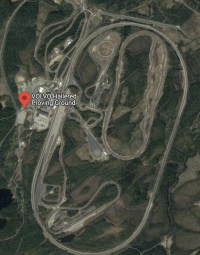 I was doing high speed testing on a big oval track that has a super bank. So when you do 220 KMPH (139 MPH) on the fourth lane up, there’s no side force. It’s like driving straight. So I had four lanes. The corners were one kilometer long, and the straightways were two kilometers long. So it was six kilometers around. And I’m doing this day after day, between 135 to 150 mph. Back then we were working with Volvo 850 turbos and the S80 came out then too. So then I just started to go lower in the oval to get more G -force and have fun. And as I was starting to do this, from lane four, lane three, lane two, and lane one is fully flat. I started to go down deeper and deeper. And I’m doing 140 miles per hour now in a long corner. I’m fully compressed with g-force. We’re doing a clockwise lap here. And I started to flick it sideways – when no one saw me. I’m drifting now at this speed full throttle in front wheel drive cars. And because I’m always traveling in the same direction the car will never flick up to the other side because I have so much g-force.
I was doing high speed testing on a big oval track that has a super bank. So when you do 220 KMPH (139 MPH) on the fourth lane up, there’s no side force. It’s like driving straight. So I had four lanes. The corners were one kilometer long, and the straightways were two kilometers long. So it was six kilometers around. And I’m doing this day after day, between 135 to 150 mph. Back then we were working with Volvo 850 turbos and the S80 came out then too. So then I just started to go lower in the oval to get more G -force and have fun. And as I was starting to do this, from lane four, lane three, lane two, and lane one is fully flat. I started to go down deeper and deeper. And I’m doing 140 miles per hour now in a long corner. I’m fully compressed with g-force. We’re doing a clockwise lap here. And I started to flick it sideways – when no one saw me. I’m drifting now at this speed full throttle in front wheel drive cars. And because I’m always traveling in the same direction the car will never flick up to the other side because I have so much g-force.
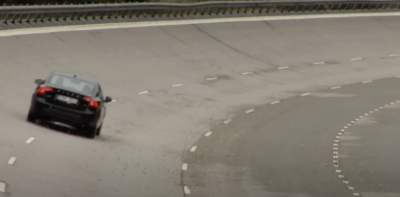 So this was a really interesting thing I learned. I felt I could flick it hard and drift at this speed and it just came back because inertia was always pushing it this way. It was totally crazy and stupid and wrong, but man, I learned you can drift at speeds of 150 miles per hour here and it will never snap on me cause I’m always turning to the right.
So this was a really interesting thing I learned. I felt I could flick it hard and drift at this speed and it just came back because inertia was always pushing it this way. It was totally crazy and stupid and wrong, but man, I learned you can drift at speeds of 150 miles per hour here and it will never snap on me cause I’m always turning to the right.
I got comfortable with high speed drifting. So when I came here and started actually drifting at D1 GP and FD I was very comfortable sideways at high speed. I had done these insane high speed slides, which I didn’t call drifting then because there was not a name for it back then. But each day I learned to be better and better at it.
Tell me about letting go of the wheel versus using fast hands. When do you want to let go and let slip through versus you want to keep up with it?
For me, it’s a natural thing. It all depends how the setup is on the car, how much work it’s doing itself. If the steering wheel goes back the correct speed you just let it go and, you know, grab it again. A lot of cars you just have to help them a little bit and make get there quick enough. It also comes down to the shortness of the wheelbase. Shorter is going to be snappier, quicker. Dodge Charger, for example, will be long and slow. So they take some time to make that rotation going. So you can just easily do it with your hands and be there. But the smaller cars, like Toyota Supra,corollas they’re going to be very snappy.
I remember when I drove a D1 car for the first time in Sweden at a drift demo. Someone brought a D1 car over there. It was so amazing. Way better than my Viper and Chargers back then. It was wider, more steering angle, and it was just easy. I would just sit back, let it go and grab it when I wanted to. I was like, wow, they know how to set these cars up. They were obviously ahead of the game back then.
How would you say that your daily driving habits are different then the average driver?
Well I mean as someone who does a lot of driving we do look around and we also can anticipate a little better what’s going on. We understand car dynamics, so before a car even gets into a tricky situation somewhere around you you know what’s gonna happen because you know the dynamics of the physical laws because you’ve seen it so many times.

I don’t do anything unnecessary. I basically keep my distance from others. And here where we have six lane high freeways, I always look over two lanes when switching lanes. You can end up in the same lane with someone else coming from that direction. I just keep distance and accelerate when you do lane changes. So you’d rather have a free gap ahead instead of going slow into lane change in a free gap behind you.
You were a driving instructor in at least a couple of places. Is there any regular advice you found that really made an impact on a students’ progression?
Look further away. It was a consistent problem with people. When you instruct someone around an autocross course or race track, they don’t look through the corner. So everything becomes a surprise.
If you look ahead and scan the road as far as you can, you know what’s about to happen when you come to a sharp corner or a longer radius corner. And it’s going to help you everywhere to just keep your eyes up further away.
Because as you travel through space you don’t need to look in front of you. It’s almost past. So that’s something we need to work with as instructors. People just look too close to the hood.
What do you see are the difficulties drifting professionals have in doing stunts?
If it’s a professional race car driver or drifter compared to someone that’s going to come and work for a camera, it’s two different whole worlds
Sometimes the director knows that race car driver who wants to do a spot for them because he’s his buddy or maybe he’s associated with the brand. They come from showing how fast they can go all the time. And here’s about showing what you could in front of the camera. And the problem is they blow by the camera. They just don’t understand the whole dynamic of working for a camera. It’s a whole different thing.
You’re taking speed DOWN in movies. You have a camera car and they have a lot of weight with four or five people inside them. So you just can’t take corners at the speed you wish. It’s not about the clock. It’s about looking good for the frames. You have to work with that vision. How would this look in the camera? And often, especially commercials, we have a lot of input and can work with directors on what looks good. So we help them pick corners. We can suggest let’s do a camera counter move here because if you counter me and go in the opposite direction it’s gonna look way faster. Because here I can not go fast, but I can get a big drift through these corners.
It took me many years to understand this. It’s not something you can go to school for. It’s about life experience. I was lucky and blessed enough to get those opportunities and not blow them, because so many things that go wrong. And in typical commercials, we don’t rehearse. There’s no time. The commercial, a lot of times, is done in one day and everything has to be working from 6 AM until 8PM, depending on when the sun goes down. Just jumping in this car you’ve never been in, you have no idea and you just have to figure it out. There’s no place to go and do any testing. Camera rolling and off we go. It’s hammer time. And it’s fun.
Tell me about a mistake you made where you learned something that changed the way you do things?
This is a situation that I will never forget, because it was really tough for me.
It was my first movie, Fast and Furious Tokyo DRIFT. I was super nervous. This was something I had dreamed about coming here. Finally, I got to be part of a movie. And Rhys Millen was the main driver, plus Tanner Foust, Rich Rutherford, and myself.
There was a scene in the garage, and I was doubling DK at night. We were doubling different people on different nights. And the director said I want you to come through here and drift through this corner. And it was this corner where he put the cameras on the inside. So if you drift around it, the angle won’t show much angle. So I’m coming around this corner, and I’m like, this is going to look like it’s straight. It’s going to look so lame. But that was the backdrop he wanted. I tried to have a lot of angle. And I was thinking, “This is all I can do.” And he said, “That’s not what I’m looking for. I want you to have a lot of angle.” And I couldn’t get it down because I’m going to spin out were my thoughts. And spinning out…coming from drifting competition… you just don’t do that!
So then they call in Rhys. And Rhy goes in and asks more details so he could better understand, “OK let me try.” And he had done movies before me. So he just came in hot and just drifted backwards and spun out. And they were applauding him, “Perfect!”
I was so surprised, “but he spun out!?” But it was past the frame. My learning was it doesn’t matter if you spin out after the shot. It’s not a competition. As long as it looks good for the frame. The frame stops right there so you can do whatever before then. So make sure you understand the Director’s vision.
So that was a brutal moment, to be kicked out of the car. He came in, did it great. He got all the applause. I was the loser. And I just walked away that night and felt terrible. That was one of those experiences.
Sam confirmed this is the actual clip where Rhys tried this stunt after Sam and spun out after the last frame on this drift turn. Samuel learned that competition <> stunt driving. Driving for the points is different than driving for the frame.
As someone who wants a car to do the things you do, you were to get a new car, what modifications would you make to that car out of the gate?
Well, first it varies what age and stage of life you are in.
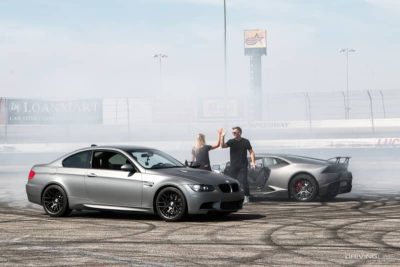 So for me, generally, if you look at what I did with my M3, I put a VF-Engineering supercharger that added another 200 horsepower, and I put a handbrake. That car actually has a good stock steering angle, plenty of what I need. And we didn’t want to modify it more because we wanted it to be a practice car (close to stock). We wanted it to be a perfect drift car for my wife, Stina, to practice drifting and do stunt maneuvers, and have fun and let our kids learn in it.
So for me, generally, if you look at what I did with my M3, I put a VF-Engineering supercharger that added another 200 horsepower, and I put a handbrake. That car actually has a good stock steering angle, plenty of what I need. And we didn’t want to modify it more because we wanted it to be a practice car (close to stock). We wanted it to be a perfect drift car for my wife, Stina, to practice drifting and do stunt maneuvers, and have fun and let our kids learn in it.
We got some other wheels for the look, mainly. And then, of course, we tried all different tires on it, which is your only contact with the ground. So those are very important.
In our case, we actually put on smaller rear tires so it’s more tail happy and it’s going to drift easier. And sometimes we use it as a camera car in different commercials and then we put on grippy tires.
But it’s been a great vehicle, this M3. It’s a 2011 E92. We changed the raw bearings, that’s the weak point in those engines, but that’s it. Stock brakes and it’s wrapped now because it looks pretty beat up. But it just keeps running. So for us it was power and the handbrake and that’s it.
This car was already equipped with amazing brakes, but with more power, you’ve got to have those brakes stop the car without fading. So that’ll be something you have to always think about.
With your kids, what are some extreme driving lessons you give (or are gonna give) them?
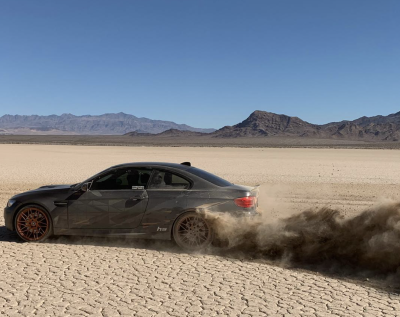 We actually took them out to a dry lake bed two years ago, put some cones out, put a booster seat in so they could reach the steering wheel, and they all learned to drive stick shift in the M3
We actually took them out to a dry lake bed two years ago, put some cones out, put a booster seat in so they could reach the steering wheel, and they all learned to drive stick shift in the M3
Last summer in Sweden, where we’re visiting our family, there’s a place designated for people to take their motorcycle license. They have a bunch of cones. So we went there and I let my kids drive slowly along the set of different courses with a stick shift. Now my 12 year old daughter is asking me, can we go practice more like we did in Sweden?
We will go to the dry lake bed and this time take the TRX truck so they can go and learn some off-road and driving too. Yeah, we started to teach them as much as we can with everything at a young age.
Driving is going to be so important to know and be comfortable to do accident avoidance maneuvers and such for them to be safe. They can feel comfortable doing lane change and just slam the brakes and turn with ABS. All those things are good for them to know. That could save their lives and others. So we’re definitely going to continue to do this. Not necessarily for any stunt work, but for their own safety and for us to have fun and see them grow.

